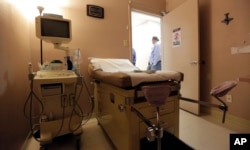The US Supreme Court could either affirm or set back abortion rights this year, depending on how the justices rule on a restrictive law enacted two years ago in Texas that has led to the closing of more than half of that state’s abortion clinics.
Only eight justices will hear arguments on Wednesday, March 2, in the case of Whole Women’s Health versus Texas after one chair was left empty by the recent death of Justice Antonin Scalia, a conservative who the law’s supporters believe would have sided with them.
The remaining justices are evenly divided between those who lean conservative and those who lean liberal, with at least two of them sometimes serving as swing votes.
But the real question in this case is not the legality of abortion, which some conservative justices may oppose, but to what degree a state can impose restrictions on the practice.
Putting up barriers to abortion?
Marcela Howell is executive director of In Our Own Voice, a black women’s advocate group that has filed an amicus brief supporting the challenge to the Texas law. She says it puts an undue burden on poor women who cannot afford to travel long distances to a clinic, especially since Texas is one of 32 states that has rejected the use of federal government-provided Medicaid funds for abortion.
She told VOA, "If they are under Medicaid they are not able to use Medicaid health insurance to cover abortion care, which adds the additional burden of figuring out how they are going to pay for an abortion.”
Howell says the law is a thinly veiled attempt to undermine the right to abortion established by the court in the 1973 Roe versus Wade decision.
“Politicians should not have a right to put up those kind of barriers to women seeking what is a constitutionally protected health care service,” she said.
A study released last month by the Texas Policy Evaluation Project documented some of the negative impacts of the abortion law on women, especially those who are poor or live in areas far from the only abortion clinic still in operation.
Protecting women’s health?
But such findings are irrelevant, according to John Seago, a legislative assistant who helped write the law. He argues that the hardships some women face are the result of abortion providers choosing to close clinics for financial reasons.
“This is a choice that the abortion industry is making, specifically, Whole Women’s Health, the plaintive in this lawsuit,” Seago said. “This is a decision they are making not to invest the money in complying with the law, but rather to challenge it in court.”
But David Brown, staff attorney with the Center for Reproductive Rights, says the law’s provisions impose medically unnecessary and burdensome requirements on the clinics.
“Particularly, there are two: there is one that requires clinics to convert themselves into mini hospitals and another that requires physicians who provide abortions to essentially join the staff of a nearby hospital.”
Seago contends that such requirements are similar to those imposed on clinics that perform plastic surgery or other elective procedures and the requirement for abortion doctors to be accepted at a local hospital helps prevent malpractice.
David Brown, however, says such requirements are transparent attempts to impede access to abortions in Texas.
“These laws are opposed by the entirety of the mainstream medical establishment in this country,” he said. “Every major medical organization, from the American Medical Association to the American Congress of Obstetricians and Gynecologists and everybody in between recognizes that these laws are medically unnecessary and impose pointless burdens, whose only effect is to shutter clinics.”
In the hands of a divided court
The death of Justice Scalia could favor the challenge to the Texas law. With him, there was a five-to-four advantage for conservatives that has now been reduced to a four-four split.
“We have lost this advocate on the court,” Seago said, “but we still are optimistic that we are going to win and that we will be able to enforce our law at the end of the day.”
Other supporters of the law agree, including Republican Governor Greg Abbott, who defeated Democratic State Senator Wendy Davis in the 2014 election after she gained national fame by trying to stop the abortion bill with a filibuster.
But those who support a woman’s right to choose an abortion, here in Texas and in other parts of the country, are hoping the court will strike down the law.
An even split on this case would leave the Texas law in effect, but would not constitute a ruling that applies to other states with similar legal restrictions on abortion.









